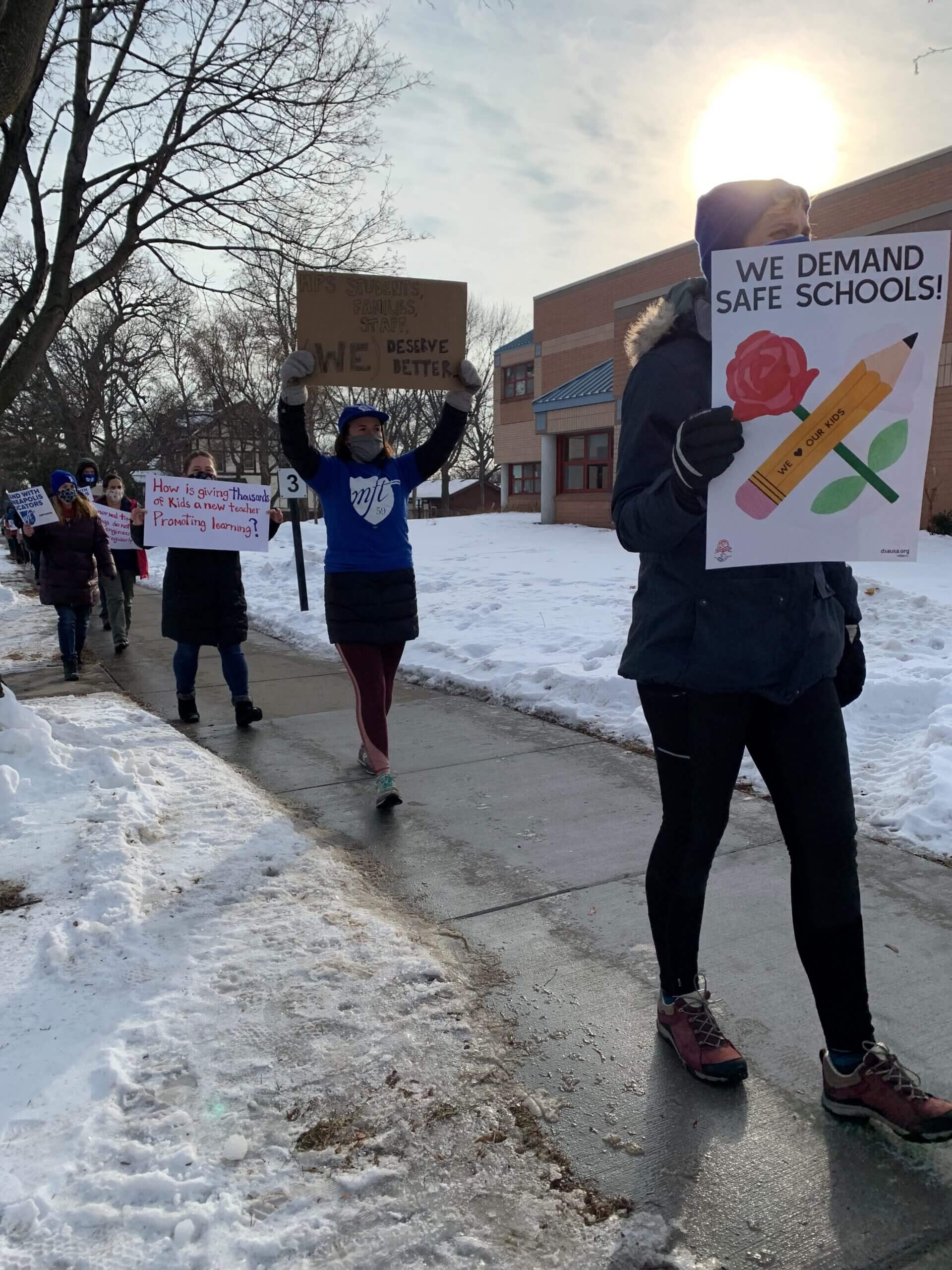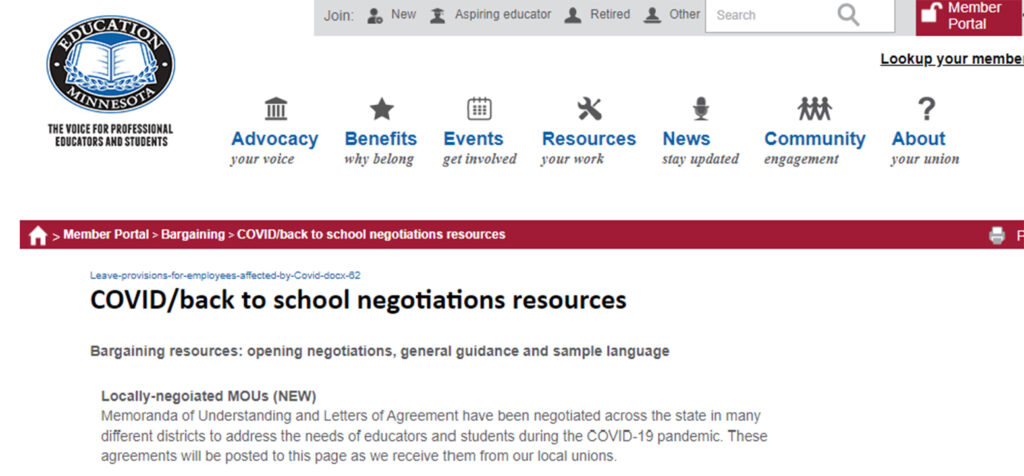The COVID-19 pandemic has changed a lot of the ways in which teaching and learning happens in and out of school buildings. For the 2020-21 year, local school districts were allowed to make decisions for their schools and communities on which learning models would be used and how. This left many local educator unions stepping in. Using the power of negotiations, many unions came to agreements with districts, making sure that the safety and health — both physical and mental — of staff and students were at the forefront of those decisions.
Minneapolis teachers take health accommodations fight to court
After spending the fall in full distance learning, the Minneapolis Public Schools announced a return to in-person learning for elementary schools to starting in February.
As plans took shape, the district told employees that it would no longer accept accommodations, including those allowing people with health concerns or who live with people with health concerns to work from home.
The Minneapolis Federation of Teachers and Education Support Professionals tried to negotiate with the district over the terms and conditions of returning to school buildings with no success.

Members of the Minneapolis Federation of Teachers and Education Support Professionals held a socially-distanced rally ahead of elementary students returning to in-person learning in February. The union filed a court order with the district after it was not going to provide any accommodations for staff as students returned to buildings, even with 40 percent of students still choosing distance learning. The union prevailed and continues to push the district to bargain over issues of student and staff safety.
“Educators are the ones on the ground who will be implementing these plans and having us at the table in the decision-making process is crucial to the success of returning to in-person learning,” MFT Teacher Chapter President Greta Callahan said in a press release in January.
After their attempts to bargain continued to be met with resistance or silence, MFT leaders took their concerns to the Public Employment Relations Board and the courts.
In late January, the MFT filed an unfair labor practice charge with the PERB.
The claim stated: “The Union has been attempting to engage in collaboration and problem solving throughout the pandemic, but the District has yet to negotiate over the critical terms and conditions of employment involved in a safe return to in-person teaching and learning. Although the Union will continue to attempt to reach resolution on these issues with the District, it is very concerned about the District’s refusal to engage in what it calls ‘formal bargaining’ over these mandatory subjects of bargaining.”
A few days before educators were supposed to report to buildings to prepare classrooms for students’ return, the union also filed a motion for a civil injunction in Hennepin County’s Fourth Judicial District Court.
The filing asked the court to stop the district from refusing to accept accommodation requests under Gov. Tim Walz’s Executive Order 20-82.
The court moved quickly and ordered that the Minneapolis Public School District could not require staff to return to work in person Monday, Feb. 1, if they had previously received or are in the process of obtaining an accommodation to work from home.
The order stated that because it understands at least 40 percent of Minneapolis students have chosen to remain distance learners, the district should be able to have educators provide remote instruction to remote learners instead of reporting to a school building to do so.
“We are happy to have our concerns heard and recognized by the court, but we are frustrated that it took legal action to get the district to abide by the rules the governor has put in place to keep workers safe during this devastating pandemic,” Callahan said after the court ruling. “This process has only caused unnecessary, additional stress on our educators, and we hope this brings them some relief.”
MFT ESP Chapter President Shaun Laden agreed that this court order is an important step, and that the unions will continue to push the district to follow their contracts and keep the health and safety of all members of the school community at the heart of their decisions.
“Educators want to be back in classrooms, in front of students, but we need to feel safe, supported and heard by our employer as we work to return to in-person learning,” said Laden said in a press release after the court ruling. “We hope this court order will bring more conversations on how we can work together so all of our students, staff, families and communities are comfortable with the plans.”
Since the end of January, the district has been following the court order as it relates to providing worker accommodations and the union is waiting on the PERB to do its investigation on the ULP claim.
Cass Lake-Bena bargain over dedicated pandemic leave
Leaders of the Cass Lake Education Association spent the last year working closely with their superintendent on COVID plans and learning models.
Co-presidents Lisa Maki-Kuhn and Molly Turner sat on the district’s COVID response team, and communicated out any updates and information to their members on a regular basis.
The district spent March to January in distance learning, due to the district serving a high population of Native American students and the health risks to their communities being higher.
Throughout the year, Maki-Kuhn and Turner engaged with their membership around what they needed in order to feel safe and supported.
One of the issues they worked to resolve was a locally negotiated, dedicated COVID leave memorandum of understanding that would replace the federal leave which expired Dec. 31, 2020.
“We started the process back in July,” said Maki-Kuhn. “We first started looking at a MOU. We sat down with our superintendent in August and went through it. I don’t think initially she thought we needed it because I think what many people didn’t understand was that the COVID leave ended on Dec. 31. I think a lot of people thought it would last the entire school year.”
Maki-Kuhn and Turner took surveys of members and presented findings to the school board, sharing out the information on why the MOU was important.
Their superintendent then saw a MOU from a neighboring district that included leave language and she showed her support for it as well.
The MOU states that teachers who are unable to work because they are diagnosed with COVID-19, are identified for self-quarantine or are providing care to a family members who is quarantining or diagnosed with COVID-19 will receive 30 district-provided “pandemic leave” days, as well as other safety and workload considerations.
“(The superintendent) thought that 30 days would really help show staff that the district cared about them and wanted them to be safe,” said Turner.
“She wanted to make sure that our staff, if anything happened and they were sick, that they wouldn’t lose their home or not be covered,” Maki-Kuhn said. “She wanted staff to know that the district appreciates everything we’ve done and they are going to support them if they get sick.”
Winona teachers address workload concerns
The Winona Education Association members have seen multiple changes in learning models over the course of the 2020-21 school year, and with that has come multiple opportunities to bargain with the district over student and staff safety and workload concerns.
In the elementary school levels, the concerns were around prep time.
“With some of our members who are at multiple buildings, especially our specialists, it really put a tight crunch on prep time,” said Linda Pfeilsticker, local union president, during a presentation at Education Minnesota’s Collective Bargaining and Organizing Conference. “And it also made it really difficult when the extra 30 minutes came in. That was great, but we didn’t know where to put them. There are 15 minutes here, 10 minutes there, whatever it was.”
The union took up the issue with the district and they agreed to a MOU that stated that “the modified safe learning elementary schedule for students K-4 does not allow for teachers to have the same number of a preparation minutes per school day but does allow for the appropriate preparation minutes per week.”

The union and district agreed that teachers will be provided with the contractual preparation time over the course of the week for the 2020-21 school year while in a hybrid or in-person learning model. That has looked like shaping Wednesday schedules in a little different fashion to address the needs of elementary school teachers, said Pfeilsticker.
At the high school, the transitions between distance, hybrid and in-person were more complicated, said Pfeilsticker.
The district and union decided to look at outside assistance to make sure teachers had what they needed to be successful.
“It came down to member mental health and physical health and we agreed to basically a distance learning teacher and we agreed to partner with Edgenuity (an online curriculum and learning platform) just for this year, understanding what we were doing was for the betterment of the entire staff,” said Pfeilsticker. “And working through that so we could address concern now, knowing it wasn’t something we were going to permanently be in.”
The MOU states that “the district would purchase additional support services through Edgenuity to assist students in need of specialized support so as not to increase the workload of the teacher providing instruction in an in-person or hybrid learning model.”
Pfeilsticker said that now, if the district wants to continue offering any kind of distance learning option to high school students in the future, they have the building blocks of what the discussion would need to look like, but for now, she is happy that her members are happy.
“That MOU made the lives of our secondary teachers much better,” she said.


